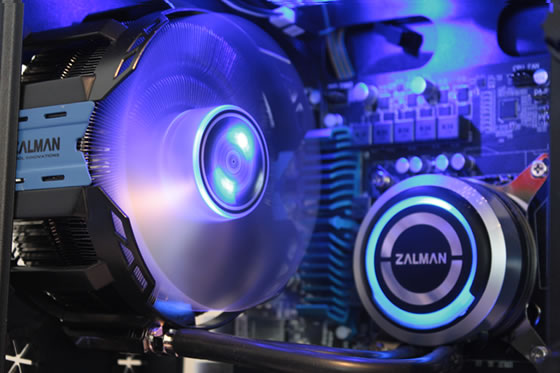Zalman Reserator 3 Max Dual. Size isn't everything

AMONG PC BUILDERS, Zalman is practically legendary. The company was the pioneer in the design of beautiful copper air coolers that offered both low temperatures and low noise. In recent years, though, the market has shifted from its "radial" or cylindrical design to blocky stacks of fins and even closed-loop liquid coolers (CLCs).
The company has been selling conventional CLCs for several years now, but it obviously decided to do something really distinctive with the Reserator 3 Max Dual. What you see in the photo functions similarly to a Corsair H100i or an NZXT Kraken X61. A pump pushes water through a set of tubes, which plugs into a radiator that has fans attached to it to expel heat out of the case. But while the pipes in a conventional PC liquid radiator flow through thin fins, the pipes in the Dual Max take a windy circuit right through the center.
Zalman also carries over its radial fin design, instead of using the squared-off rows that we're used to seeing. The visual impact of this deviation from the norm is immediate and impressive. These two sets of radial fins are spaced a little farther apart than a standard 240mm radiator, so you may need to install the bundled set of brackets to make your screw holes line up correctly-we did on our Corsair 900D case. The process is a bit fiddly and uses a number of tiny widgets, but the manual does a solid job of explaining how everything fits together. It didn't say which set of screws we were supposed to use, but after a little deductive reasoning, we used the loose ones in the bottom of the bag. The radial fins also stack pretty high; once you include the integrated fans in the measurement of the unit, you're looking at a height of 73mm, or about 2.9 inches. This is nearly the size of a standard radiator with fans installed on both sides, so there are a number of cases in which this unit simply won't fit. After finishing installation, we noticed that the pump was noisier than average, even on a low setting, but it wasn't distracting when the case's side panel was on. The fans were quieter than normal, considering how much air they were moving-up to 2,000rpm. There's a 500rpm gap between the two highest speeds in the fan profile, though, so you'll hear a lot of engine-like revving if your temperature readings are floating on a threshold between the two speed settings.
We had to select our speeds manually to avoid this revving. This cooler doesn't come with software to do that, so you'll have to control that in your motherboard's BIOS, or in the Windowsbased fan control software that may come with your board. Unfortunately, even the most aggressive cooling scenario couldn't keep up with the current top coolers. Under load, the performance of the Reserator 3 Dual Max was better than a tower-style air cooler, but not enough to justify the premium. With a street price of $140, you need to make a splash, but this CLC doesn't cause much of a ripple. The H100i currently goes for $100 and is still one of the best CLCs on the market, and a Cooler Master Hyper 212 Evo performs within spitting distance of the Dual Max and comes in around $35. While the Dual Max does perform better than air, it's difficult to recommend it over its competitors.
|
|



